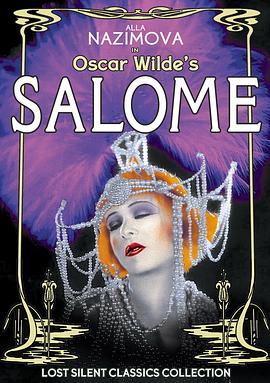更新时间:2024-04-13 01:38
详细剧情
Salomé (1923), a silent film directed by Charles Bryant and starring Alla Nazimova, is a film adaptation of the Oscar Wilde play of the same name. The play itself is a loose retelling of the biblical story of King Herod and his execution of John the Baptist (here, as in Wilde's play, called Jokaanan) at the request of his stepdaughter, Salomé, whom he lusts after. Salomé is often called one of the first art films to be made in the U.S.[citation needed] The highly stylized costumes, exaggerated acting (even for the period), minimal sets, and absence of all but the most necessary props make for a screen image much more focused on atmosphere and on conveying a sense of the characters' individual heightened desires than on conventional plot development. Despite the film being only a little over an hour in length and having no real action to speak of, it cost over $350,000 to make. All the sets were constructed indoors to be able to have complete control over the lighting. The film was shot completely in black and white, matching the illustrations done by Aubrey Beardsley in the printed edition of Wilde's play. The costumes, designed by Natacha Rambova, used material only from Maison Lewis of Paris, such as the real silver lamé loincloths worn by the guards. No major studio would be associated with the film, and it was years after its completion before it was released, by a minor independent distributor. It was a complete failure at the time and marked the end of Nazimova's producing career. A longstanding rumor, which seems to have started while the film was still in production, suggests that its cast is comprised entirely of gay and bisexual actors in an homage to Oscar Wilde, as per star and producer Nazimova's demand. It is, of course, impossible to say, but one of the extras in Salomé reported that a number of the cast members—both featured and extras—were indeed gay, but not an unusual percentage of them, and certainly not all of them. What can be said is that Nazimova herself was a lesbian, the two guard characters (who, next to Salomé, have the most screen time) are at least played very stereotypically gay, and several of the female courtiers are men in drag. Salomé was screened in 1989 at the New York International Festival of Lesbian and Gay films and in 1990 at the New York Gay Experimental Film Festival. In 2000, the United States Library of Congress deemed the film "culturally significant" and selected it for preservation in the National Film Registry.





















the mystery of love is greater than the mystery of death/服裝美爆/女主角跟John怎麼都這麼正!
4。Salomé Salomé dance for me , so shit dance nimeia
确实这个莎乐美大部分时候都不是很“魔性女”...倒是那件反色千鸟格的袍子真好看
七纱舞那段略囧
+怪不得credit里少有的把服装设计放在这么前的位置,本片无论是服装、美术设计还是布景和镜头都十分亮眼。+默片与戏剧的完美结合。-Nazimova是很美,可是真的很不喜欢她所演绎的莎乐美,更不用提那编舞了。(ps:nice boat是不是就是受莎乐美启发?)
Rambova's exotic reverie dominated the surrealistic world, never faded.
超好看!秒变默片粉!背景音乐和道具声响站到幕前引领剧情,控制节奏。演员夸张的表情和动作极细腻而富有感染力。这部年代早,扮相,妆容,肢体动作十分古典唯美,透着永恒的悲剧意味。文字只在极重要的位置出现,反而更让人捉摸,欣赏和思索。表现Salome的性格和其他角色爱,恨,欲都挺到位。
大概因爲看的時候超不專心,所以沒覺得很好看,説到底這個版本的salome太艷俗了
造型和设计太美了,是带点cult风格的默片版本,即使是现在看来也依旧很时髦,人物神态和肢体语言虽然很夸张但细节很到位。这版的先知约翰既像老者又像少年气质很神秘,莎乐美的娇憨和冷酷也很迷人。
还原 比亚玆莱
王尔德
碍于渣画质,没办法看清楚原本的美术功底精细程度。默片依靠强大的背景和夸大特写反而是降低了力量。
一股cult味,风格很比亚兹莱!服装设计是兰博娃小姐~~(又在默片看到侏儒症患者充当小丑……不是滋味)
那种cult味还真有点意思
舞美和Nazimova太棒
一开始觉得很脸谱化,后面最后处死约翰的时候,被人性的癫狂折服了,可以一看,那句“爱的秘密远比死亡的秘密更高”真的很王尔德了
youtube上看的。
高度风格化/舞台化。The Prophet的演员选的非常好,苦涩而有基督感。
孔雀很美;七层纱好丑;音乐不错,表演不错,人物不行
昨晚在宝砂胡同的Modernista看这部备受争议的作品,silent movie with live music and voice,诡异的人声吟唱与电音配合得非常好,very breathtaking, very impressive. "She kills the thing she loves; she loves the thing she kills."